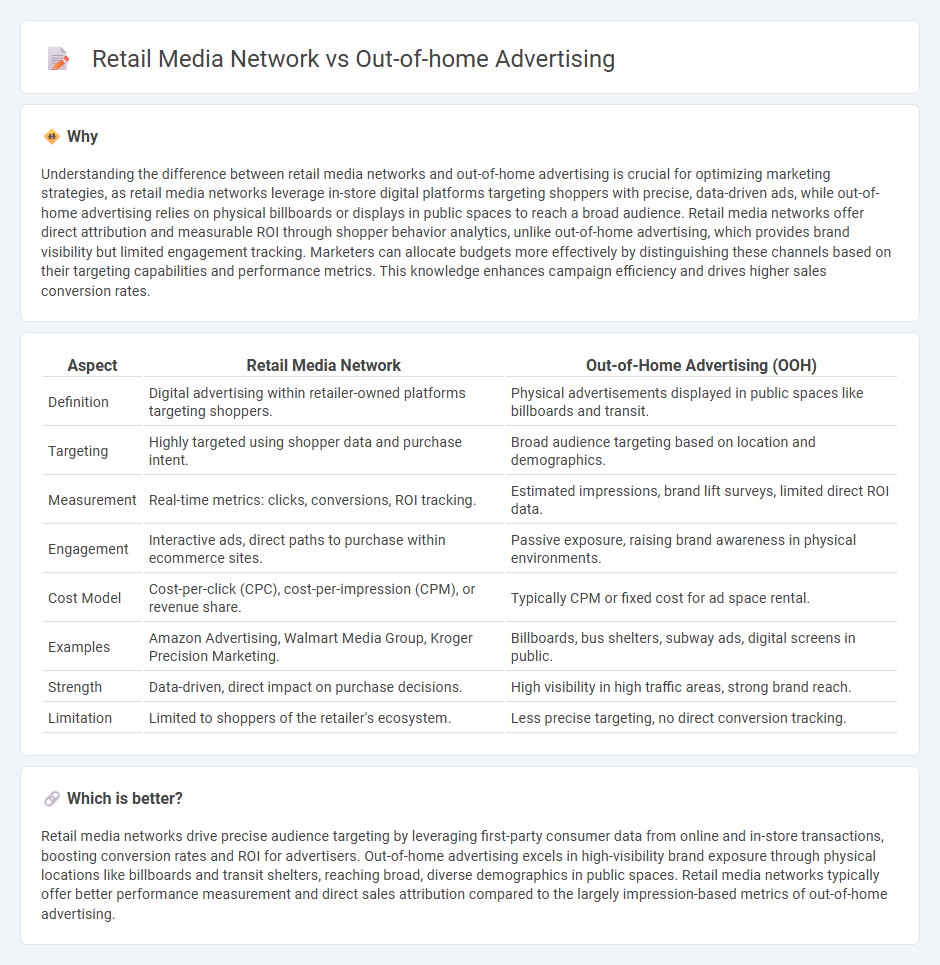
Retail media networks leverage data-driven advertising within digital commerce platforms to target consumers at the point of purchase, enhancing personalization and conversion rates. Out-of-home advertising relies on physical displays like billboards and transit ads to capture broad audience attention in public spaces. Explore the advantages and applications of these marketing channels to optimize your advertising strategy.
Why it is important
Understanding the difference between retail media networks and out-of-home advertising is crucial for optimizing marketing strategies, as retail media networks leverage in-store digital platforms targeting shoppers with precise, data-driven ads, while out-of-home advertising relies on physical billboards or displays in public spaces to reach a broad audience. Retail media networks offer direct attribution and measurable ROI through shopper behavior analytics, unlike out-of-home advertising, which provides brand visibility but limited engagement tracking. Marketers can allocate budgets more effectively by distinguishing these channels based on their targeting capabilities and performance metrics. This knowledge enhances campaign efficiency and drives higher sales conversion rates.
Comparison Table
| Aspect | Retail Media Network | Out-of-Home Advertising (OOH) |
|---|---|---|
| Definition | Digital advertising within retailer-owned platforms targeting shoppers. | Physical advertisements displayed in public spaces like billboards and transit. |
| Targeting | Highly targeted using shopper data and purchase intent. | Broad audience targeting based on location and demographics. |
| Measurement | Real-time metrics: clicks, conversions, ROI tracking. | Estimated impressions, brand lift surveys, limited direct ROI data. |
| Engagement | Interactive ads, direct paths to purchase within ecommerce sites. | Passive exposure, raising brand awareness in physical environments. |
| Cost Model | Cost-per-click (CPC), cost-per-impression (CPM), or revenue share. | Typically CPM or fixed cost for ad space rental. |
| Examples | Amazon Advertising, Walmart Media Group, Kroger Precision Marketing. | Billboards, bus shelters, subway ads, digital screens in public. |
| Strength | Data-driven, direct impact on purchase decisions. | High visibility in high traffic areas, strong brand reach. |
| Limitation | Limited to shoppers of the retailer's ecosystem. | Less precise targeting, no direct conversion tracking. |
Which is better?
Retail media networks drive precise audience targeting by leveraging first-party consumer data from online and in-store transactions, boosting conversion rates and ROI for advertisers. Out-of-home advertising excels in high-visibility brand exposure through physical locations like billboards and transit shelters, reaching broad, diverse demographics in public spaces. Retail media networks typically offer better performance measurement and direct sales attribution compared to the largely impression-based metrics of out-of-home advertising.
Connection
Retail media networks leverage shopper data and in-store insights to optimize out-of-home advertising campaigns by targeting consumers with contextual, location-based ads. Integration of these platforms enhances ad relevance and engagement, driving higher conversion rates both online and in physical retail environments. The synergy between retail media networks and out-of-home advertising creates a unified commerce ecosystem that maximizes ROI for brands and retailers.
Key Terms
Audience Reach
Out-of-home advertising delivers broad audience reach through strategically placed billboards, transit ads, and digital screens in high-traffic public areas, capturing diverse demographics in real-time. Retail media networks leverage first-party shopper data to target highly specific consumer segments across digital and in-store channels, enhancing precision and purchase intent. Explore how these platforms optimize audience engagement to elevate your advertising impact.
Point of Purchase
Out-of-home advertising captures consumer attention in high-traffic locations through billboards and transit displays, while retail media networks leverage point-of-purchase data within stores to deliver targeted, personalized ads that influence buying decisions. Retail media networks provide precise audience segmentation and real-time analytics, enabling brands to optimize campaigns directly at the moment of purchase. Explore how integrating these strategies can maximize retail impact and drive sales conversion.
Attribution
Out-of-home advertising offers broad brand visibility by targeting audiences in public spaces, while retail media networks enable precise attribution through direct integration with retailer sales data, linking ad impressions to actual purchases. Retail media networks leverage first-party consumer data and advanced analytics to measure incremental sales, providing advertisers with real-time insights into campaign effectiveness. Explore how combining these channels can optimize your marketing attribution strategy.
Source and External Links
What is out-of-home (OOH) advertising? A beginner's ... - Out-of-home (OOH) advertising, also called outdoor advertising, involves billboards, signage, and other impactful media placed in public spaces, offering high consumer recall and a way to connect outside personal devices.
OOH Advertising: Everything You Need to Know - Camphouse - OOH ads appear outside the home on highways, transit stops, airports, and digital city displays, and are evolving through digital out-of-home to enable dynamic, location-based campaigns.
Out Of Home Advertising (OOH) - All You Need To Know In ... - Traditional OOH formats include billboards, bus shelters, benches, and street furniture, and serve as a powerful complement to digital ads with high visibility and impact.
 dowidth.com
dowidth.com